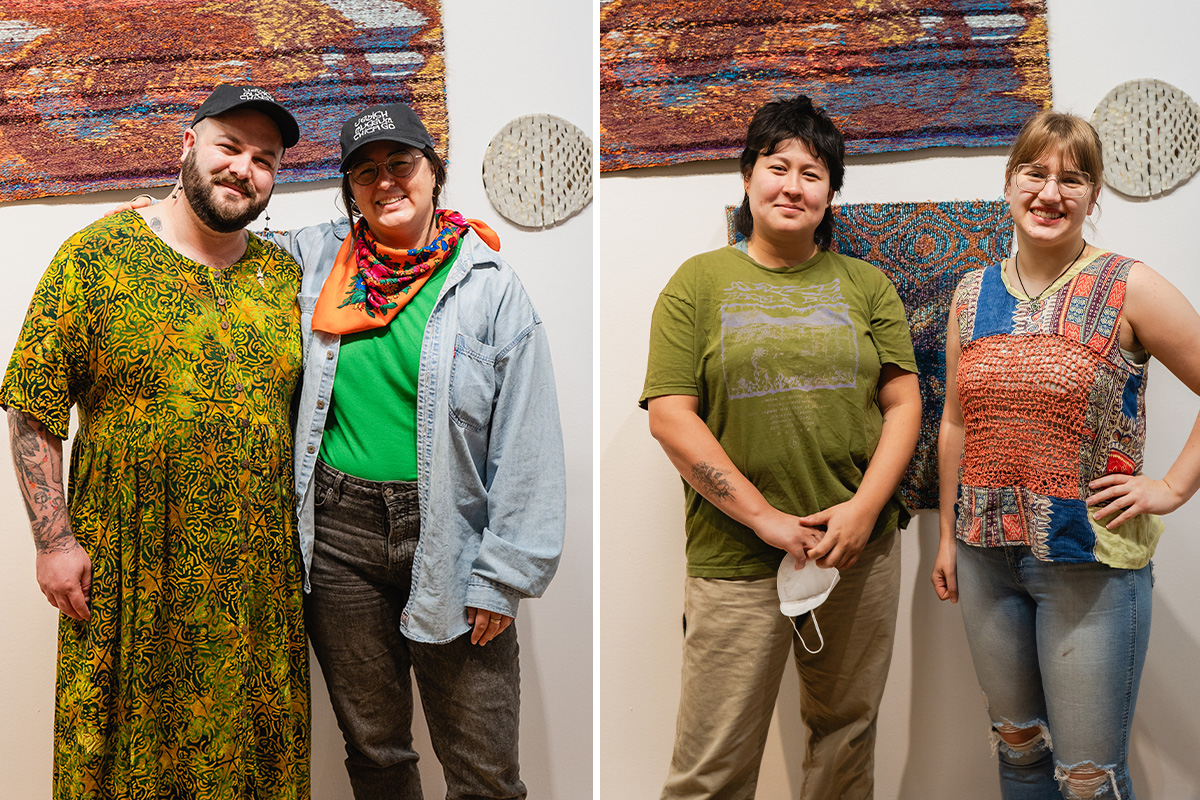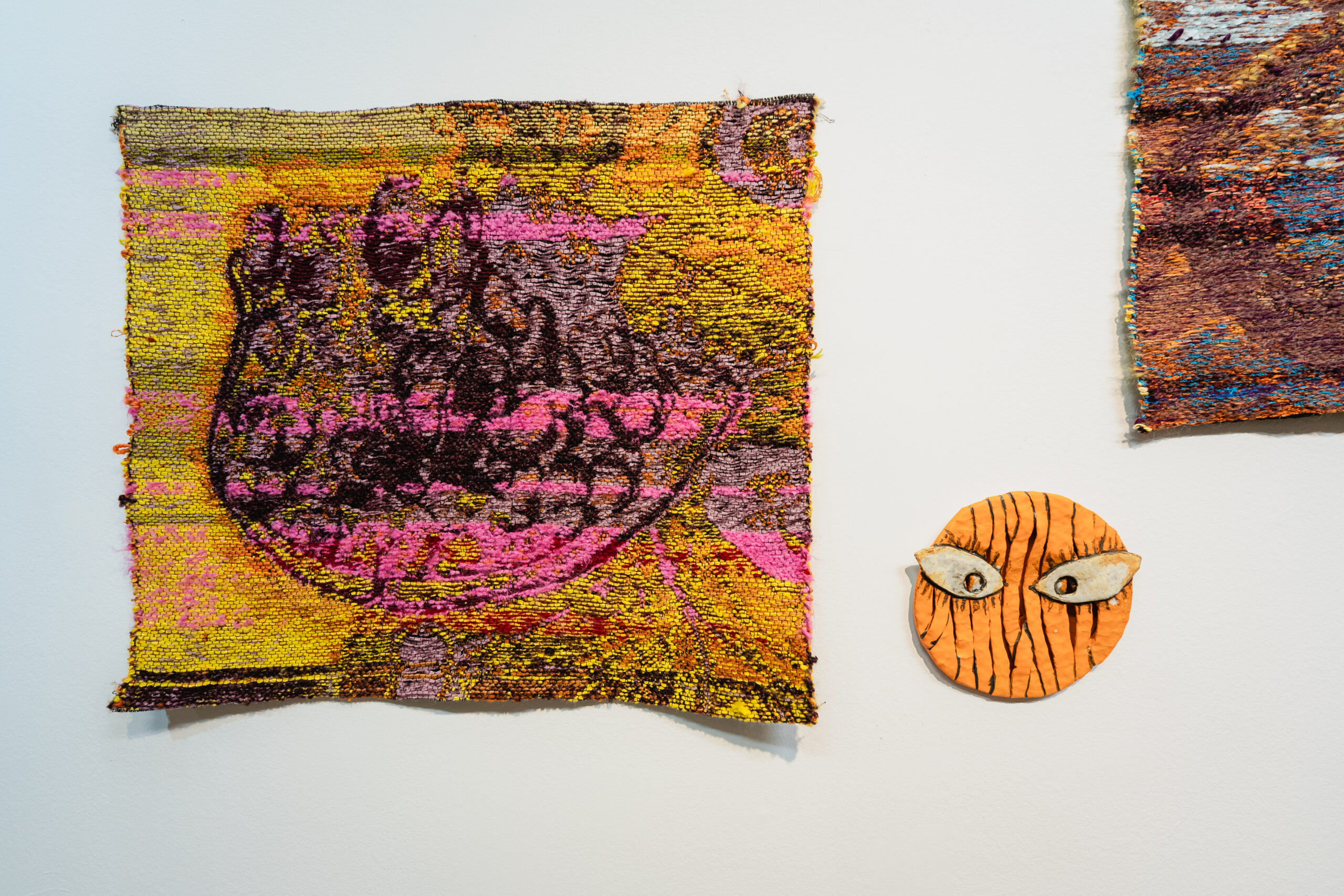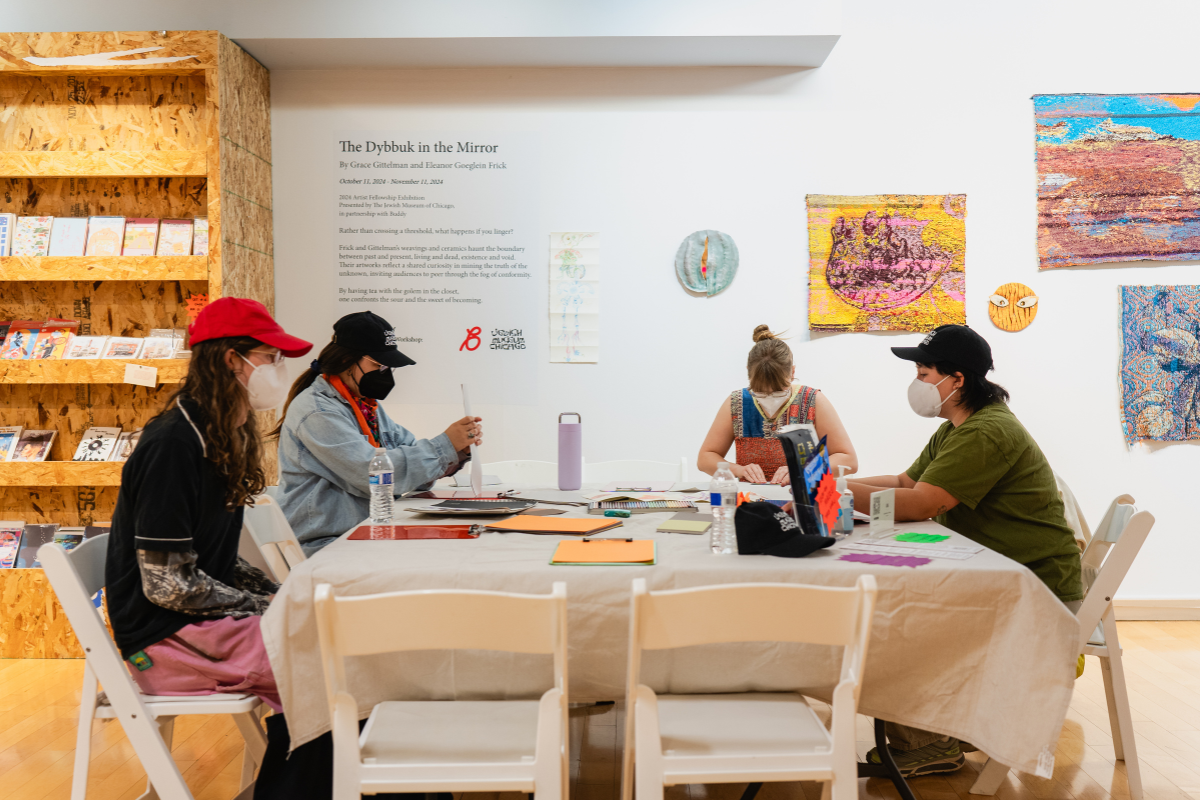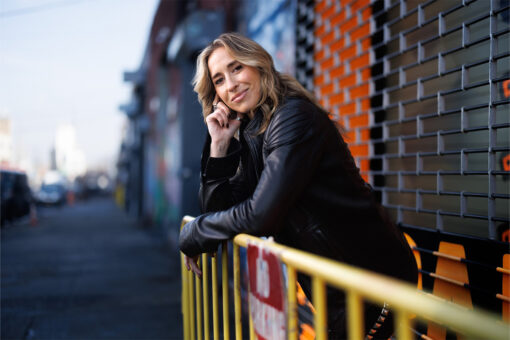At the core of “The Dybbuk in the Mirror” art exhibition are two sets of creative partners who both began their journey as strangers.
Maya Kosover and Gabriel Chalfin-Piney met the way most people meet friends and creative partners: on a cross-country road trip to a Jewish arts retreat to learn how to make ritual items out of deer hide.
On the way to learn the craft of mezuzah parchment and shofars, they spent hours upon hours in the car talking about their craft, about Judaism and about the difficult, rupturing past year.
“It was a very magical summer that created the partnership, and the whole car ride there and back, we were just ideas, ideas, ideas,” Kosover said.
Painter and fiber artist Eleanor Frick and ceramicist Grace Gittelman initially submitted individual applications for the first Artist Fellowship from the Jewish Museum of Chicago, a community-run museum crafting accessible, multigenerational entry points to diasporic community building, organizing and cultural art practices, stewarded by Kosover and Chalfin-Piney. [Editor’s note: Eleanor Frick is the sibling of Evelyn Frick, associate editor of Hey Alma. Evelyn did not have any role in writing, editing or producing this article.]
Chalfin-Piney and Kosover received about 20 applicants for the Artist Fellowship, in partnership with artist-run space Buddy, and were struck by not only Frick and Gittelman’s art, but the way they wrote about their art, and sought to find a way to platform their work together.

“We brought [Grace and Eleanor] together, but they really did that work and they came up with what the story of the show was and the programming they wanted to run with it,” Kosover, the museum’s Artistic Director, said. “By chance and perfect coincidence, they were able to put something together that we also fully believed in and wanted to get behind.”
“I think a lot about improvisation in the art world and how something with a small set of rules can become something very beautiful,” said Chalfin-Piney, the museum’s Founding Director. “We were offering space and support for Eleanor and Grace, but really let them direct the exhibition, and seeing this budding collaboration based on two strangers is a really beautiful thing.”
“The Dybbuk In The Mirror,” where Frick’s tapestries hang alongside Gittelman’s ceramics, both full of intricacy and color, runs through Nov. 11 at the Buddy space, inside the Chicago Cultural Center. Referencing the Jewish mythical creatures of the dybbuk — a spirit, often portrayed as malevolent, that can enter a living person — and the golem — a clay figure given life associated with both protection and destruction — “The Dybbuk In the Mirror” explores the boundaries between past and present, life and death, the veil between worlds.
“Their artworks reflect a shared curiosity in mining the truth of the unknown, inviting audiences to peer through the fog of conformity,” wrote Gittelman and Frick in the exhibition statement. “By having tea with the golem in the closet, one confronts the sour and the sweet of becoming.”
One challenge was the difference of approach — Frick had already made the works she wanted to include in the exhibition when she applied, but Gittelman made their pieces after the two had written the exhibition description, which was a different way of working for them. As a ceramicist, Gittelman was thinking about the nature of the golem as a creature made from clay, but did not want to pigeonhole themself or take a literal approach to that concept.
“We have these repressed memories, these generational traumas that live within us, that become a golem or a dybbuk in our minds,” they said. “I was trying to stray from the idea of actually creating a golem and creating more of a portal in which to sit with yourself and sit with the golem or the memories that you have and reflect upon them.”
As a result, this body of work is different for Gittelman. “I really wanted to challenge myself to work in more of an abstract way, to really push myself to rely on the pinching and touch of my hand on the surface rather than carving into the surface and making it more illustrative,” they said.

Gittelman and Frick said another strong commonality they share is the materiality of their work, and the way they lean into the use of color, something that can be seen throughout the exhibition.
“We’re not afraid of the gaudiness and the memory that color has,” Gittelman said. “Some artists can be a little tentative with their use of color because they’re kind of worried about leading their viewer to a specific type of kitsch or gaudy moment, and both of us are really unafraid of that aesthetic.”
Thematically, as the two artists conversed and collaborated, they found many similarities without them feeling forced together.
“We found so many common threads of diaspora and what it means to be an outsider, feelings of imposter syndrome and how a lot of things that are unsaid about our identity and who we are as people that we try to express through our work,” Gittelman said.
Gittelman grew up with stories of the golem, and say they felt drawn to the mythic creature’s conflicting intentions of the golem as a protector and a destroyer. They say they were less familiar with the dybbuk, but began researching its mythology for the exhibition.
“I realized the dybbuk was less ill-intended than I originally thought,” they said. “It had to do with memories that were repressed and spirithood that was entangled in that in between that we explore in our work, the inbetween of memories lost and memories retained.”
Growing up in a Sephardic family, Frick grew up hearing golem stories, but feeling like they couldn’t claim it as part of their culture.
“I was always even as a child interested in monsters and myths, but growing up in a really Ashkenazi dominant Jewish community, I didn’t have any Sephardic monsters I could identify with,” they said. “The golem was something that was always fascinating to me, also as an artistic person, this is cool because you can make this monster, it comes from you, and then the whole idea that you give it life by inscribing the word on its forehead or putting knowledge into its mouth, spoke to me as unique among the pantheon of monsters.”
Both artists were drawn to the way the golem, as a created monster, speaks to the life of the artist.
“That concept of imbuing spirit onto an object and onto a figure always really struck me,” Gittelman said. “I did a lot of other mediums before I came to ceramics, and that was something that connected to me, that idea of you molding something out of clay.”

As the two artists held visioning conversations about monsters and myth, conversations about a more real and present monster emerged and can be found in the work of the exhibition — grief, and how it lingers and shapes you. In particular, both expressed a strong sense of grief around the Israel-Hamas War and the killing and displacement of Palestinian civilians in Gaza by the Israeli military.
“As somebody whose direct lineage was colonized by Japanese forces, and as someone who is now witnessing the colonization of Palestinian people and their land, it’s very difficult for me to feel my art is going to make a difference in the world,” Gittelman said.
“We came to the dybbuk as the repressed spirit, the skeleton in the closet of Jewish grief and anger and sadness at this moment, and the whole idea that these atrocities are being done in our name and that it’s fraught to speak about in our own community,” Frick said. “It’s a huge wound that Grace and I feel, so I felt like we would be dishonest to the core of the show if we didn’t stare that down and deal with it.”
For the exhibition, Gittelman wanted to create works that reflect the idea of grief and the feeling of their Korean and Jewish cultures. “Some of the things I’m referencing are the Jewish custom covering the mirrors in the house when a loved one dies, and that was kind of my starting point,” they said. “From there, I referenced abstractly a few different Korean things, veils that I’ve seen in the world, such as the netting that goes around a Korean pear in the grocery store, something that mundane but that to me in my mind makes me think of a veil, there’s a little insight into the hybridized ceramics and thinking of all of me as a being.”
Frick draws inspiration from Midwestern aesthetics for her colorful tapestries, weaving the aesthetics of migration and assimilation through a queer Jewish sensibility. Their family is Macedonian Greek, and their great-grandfather came to the United States as a refugee migrant worker to escape World War I. Their art, they say, is a way to process the devil’s bargain of white supremacy and assimilation, and the sense of betrayal of watching their family celebrate their heritage while supporting virulently anti-immigrant politicians and ideologies.
“It’s calling out the hypocrisy and grieving what I cannot change about myself and relying on those Midwestern immigrant-adjacent aesthetics,” Frick said. “It’s like the aunt who always wears fake fur leopard print coats, the costume jewelry and makeup — to me, that all symbolizes the anxiety of being ‘American enough.’ I think my tapestries are how I deal with that grief and also try to come to terms with it, but in a socially responsible way.”
The Jewish Museum of Chicago is not yet a physical space, to the point it’s become something of a running joke — they have received at least 50 emails from people asking to contribute work to their collection and where they are located — but it is filling a need in the community for support for contemporary Jewish artists, Chalfin-Piney says.
Kosover says a core tenet of the project is one of subverting the elitism, hierarchy and gatekeeping often found in museum and fine art institutions.
“What the Jewish Museum of Chicago wants to do is empower everyday people,” they said. “It’s not like I walk into a museum and they’re the artist and I’m the observer. There are ways we’re flipping that on its head and inviting everyone into their artistry and creativity. I think the times we’re living in are a crisis of imagination and the more people tapped into their imaginations, that’s what’s going to fuel our future and our community.”
So far, Frick said the exhibition has received a positive response, and they hope those who visit the Buddy space before Nov. 11 come away with a sense of confrontation, but not one that is necessarily aggressive — where guests engaging with the art can confront and make peace with whatever grief, memories or emotions the works dredge up.
“I would like people to think about what they choose to hide from themselves and why they choose to hide those parts of themselves,” Gittelman said.

Kosover says the museum team will be taking a rest period following “The Dybbuk in the Mirror,” and focus in the near future on ensuring the museum is sustainable and not operating from a place of burnout. They hope to have some community listening and visioning sessions in early 2025 to welcome the exciting ideas community members have brought forward.
“Our voice and our stories are the most important things we have,” Chalfin-Piney said. “When those stories aren’t told, we lose parts of history, and there’s an aspect around these artists’ work that’s building a visual and oral history and it’s deeply important to me that they are seen and experienced and cataloged. That community and belonging feels very important.”
“The Dybbuk in the Mirror,” the Jewish Museum of Chicago’s 2024 Artist Fellowship Exhibition, is on view through Nov. 11, 2024 at Buddy, Chicago Cultural Center.



